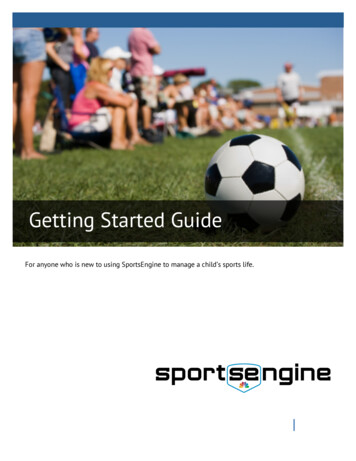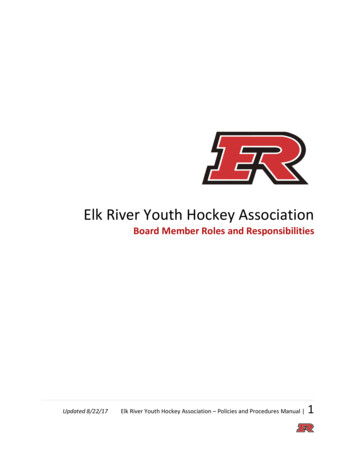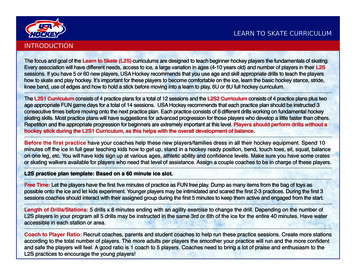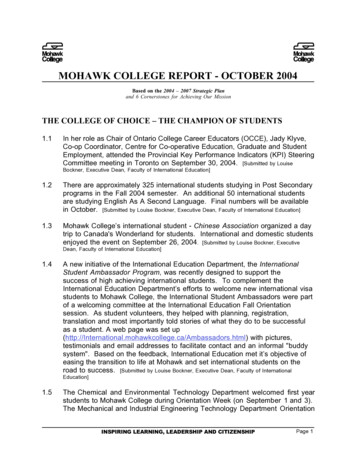
Transcription
USA Hockey Team BuildingThis material was put together as a guide for coaches to engage your athletes in a fun, creativemanner away from the ice rink. In any short term event, where the athletes are thrown together, thequicker you as a coach can break down barriers and have the group working together as a team, themore success the team will have.This guide is a small collection of exercises and challenges that have been done at many of ourNational Player Development Camps. If you have your own initiatives, we encourage you to use whatyou believe will work best for you and your athletes. However, we hope this guide will provide youwith several new ideas and spur your creativity, as well as your players.Getting StartedAs the leader, you can use these initiatives to teach a variety of essential skills and attributes to yourathletes like teamwork, communication, adaptability, ingenuity, creativity, courage, focus and trust.Each of these are desirable qualities within a team. To bring out the best in your players andmaximize your activity the underlying element must always be FUN. And, as the leader of group, it isyour job to maximize the experience for your athletes.With this type of “Adventure Learning,” the leader facilitates the activity. However, it is importantthat not all the answers are provided to the team, they should learn from each other. The athlete’ssuccesses and failures provide unique teaching opportunities for them to grow.Yogi Bara once said, “You can observe a lot by watching.” These activities will provide a differentinsight into the individuals that make up your team and their dynamics. Pay close attention and muchcan be revealed.As the facilitator or leader, your challenge is to know when and when not to intercede. The verynature of these activities includes a certain amount of unpredictability. It is your responsibility to beadaptable as well. In this type of learning environment, more often than not, it is important for thefacilitator to get out of the way and let the athletes sort out the problem by themselves.When to intercede? Always be aware of safety issues for your group. If you anticipate that thephysical safety of the participants may be in jeopardy, step in and make an adaptation to preventinjury. If the group is having too much difficulty and a high level of frustration is setting in, it may betime for the leader to step in, give advice or move on. This is where your judgment is key. While ateam can learn from its failures, much more can be learned through overcoming great obstacles. Withthis type of problem solving, it is your job to be a facilitator, not a teacher. Remember, it’s not yourjob to save them, they need to learn to save themselves!ImaginationIt can be amazing how the level of intensity will increase when the game or initiative has some smallbackground story to it. When a gym floor is just a gym floor, the activity may be fine. However, whenthe gym floor is represented as the deadly, shark-infested waters off your island of safety, it can beamazing how much more involved your participants can become. Kids are kids, and if you sell thescenario right, an extra level of fun and excitement can had for all.DebriefingWith out a debriefing at the conclusion of an exercise, your athletes will have participated in a fun,group activity, but they will not have gained the full benefit. By reviewing the exercise, you allow theathletes to process and digest their results. They will gain a better understanding on what went welland what didn’t. Hopefully, they will learn some lessons that will help them grow into being betterteammates and ultimately a better team.
Ice BreakersIce breakers are activities with an emphasis on breaking down the initial barriers between individualgroup members. It is impossible for a group of individuals to work together like a finely turnedmachine without first becoming familiar with each other and trusting one another.List of Ice Breakers:Around the CircleBiosNote Card FactsFact SheetCall Your BluffName Game – Six VariationsMust Learn TenTruth or LieWinner’s CircleFootball Pass
Around the CircleIndoor ActivityEquipment Required: NoneDescription: Gather group in a large circle. The first person starts with their name and which waythey shoot (L or R); the next player, to the left, repeats the previous player’s name and shot and thenadds their own. This continues until a mistake is made and then starts over with the last player andmoves in the opposite direction.BiosIndoor ActivityEquipment Required: Index cardsDescription: Each athlete and staff member write his/her name, hometown and short bio on an indexcard. For example, favorite food, music, movie, sports team, as well as one dislike and favorite nonhockey activity.The leader shuffles the cards and gives everyone a card at random. Have each participant read theircard to the group. When all are read, the leader collects the cards and then goes through calling outnames. The group must state what they remember about each person.Note Card FactsIndoor ActivityEquipment Required: Note cards, pens or pencilsDescription: Players write down information about themselves on a note card. Pass the note cardsaround the group and have the group guess which player the card is about.Fact SheetIndoor ActivityEquipment Required: Note cards, pens, pencils and paperDescription: Have each player turn in a note card to the leader with two or three facts about his/heron it. The leader then puts all the facts onto a single sheet of paper.In a group setting, players guess which facts are about which players.
Name GameIndoor ActivityEquipment Required: BallDescription: Players stand in two lines across from each other. Player states his name, nickname andhometown while passing a tennis ball across to another player. The new player catches the ball andsays “thank you (name) from (hometown).” Then that player states his own name and hometown andpasses the ball to another player. Continue on down the line until all players have participated.Name Game, Variation 2, Family Name GameIndoor ActivityEquipment Required: NoneDescription: In the locker room, player state his/her name and the name of his/her mother, fatherand any siblings. The player to the left says, “This is (name) son or daughter of (parents’ names) andhas brothers (names) and sisters (names).” This player continues, “My name is ” This sequencecontinues around the room.Name Game, Variation 3, Nickname GameIndoor ActivityEquipment Required: NoneDescription: Partners take 30 seconds with each other. Using the first letter of a players namehis/her partner comes up with a creative, descriptive word. Be sure to use language and terms thatare appropriate. An example is “Fast Fred.” Use these new nicknames for the players. Share the nicknames with the team.Name Game, Variation 4, Competition Name GamesIndoor ActivityEquipment Required: NoneDescription: Divide the group into two teams. Tell the teams to line up by last name in alphabeticalorder. First to do so wins. Next, have them line up by first name in alphabetical order.
Name Game Variation 5Indoor ActivityEquipment Required: NoneDescription: Players sit in a large circle. They must think of a word that begins with the first letter oftheir first name. It must be a positive word! Example: Jumping John.The first player starts by introducing himself as “Jumping John.” The player to the right says, “this isJumping John and I’m Terrific Tom.” The next player to the right says, “That’s Jumping John, TerrificTom and I’m Fabulous Fred.” This continues until the entire group is introduced. If a player can’tremember someone’s name, start over from the beginning.Name Game, Variation 6Indoor ActivityEquipment Required: Name tag stickers, pen and stopwatchDescription: Coach writes a variety of celebrity names on the name tags. The team stands at thefront of the room facing a wall while the coach sticks a tag on each player’s back. Each team is givenone name from each category. For example: hockey, basketball, football, base ball, movie stars,pop/rock stars, etc.On coach’s start, players look to see the names on the backs of their teammates. At this point, eachplayer tries to identify the name on his/her back by asking questions. Teammates responses can onlybe “yes” or “no.” Once a player guesses who he/she is, he/she begins answering questions for his/herteammates. The team that guesses all their names first, wins.Example:The name is Joe SakicPossible Questions:Am I a man?Am I a movie star?Am I an athlete?Am I a hockey player?Am I a forward?Do I play for Toronto?Do I play for Colorado?Am I Joe Sakic?yesnoyesyesyesnoyesyes
Must Learn TenIndoor ActivityEquipment Required: NoneDescription: Pair off team members with someone from another part of the country. Give the playersfive to seven minutes to learn ten different facts about each other. After the allotted time, eachplayer relays the ten facts that they learned about their partner to the entire groupTruth or LieIndoor ActivityEquipment Required: NoneDescription: Divide the group into two teams. Each player states two interesting facts aboutthemselves and a third fact that is not true. The opposite team gets to take one guess to determinewhich fact is false.Truth or Lie, Variation 2, Call Your BluffIndoor ActivityEquipment Required: NoneDescription: Players select a partner from another part of the country and take five to ten minutes tointerview each other. Each player should try to learn as many interesting facts as they can.Next, each player introduces his/her partner to the rest of the group. At the conclusion of theintroduction, the player making the introduction offers an anecdote or unusual fact about the partner.The player may embellish the statement or create something completely false.Players should avoid simple background statements such as “John has four sisters and a pet snake.”Some insightful replies might be “my great-grandfather shook hands with the Queen of England” or“my Uncle Bob played professional rugby in Australia.”The group then decides if the statement is true or false. The coach has players move into respectivegroups, true believers on one side and false believers on the other.
Winner’s CircleIndoor ActivityEquipment Required: NoneDescription: Players sit or stand in a circle. Each player says something positive about the teammateon the right in terms of what you appreciate about them.Debriefing Tips: Players experience an increase in confidence, a boost in self esteem and feelings ofbeing valued by the team.Football PassIndoor / Outdoor ActivityEquipment Required: FootballDescription: Divide the group into two teams. Teams must pass the football around a circle byholding either the point or middle of the ball. Alternate point and middle each passer. The first teamto complete the circle wins. Once the activity has been accomplished, have the passer say his/herown name and the name of the player they are passing to.
InitiativesInitiatives are problem solving activities that create learning opportunities for your athletes. These‘Adventure Learning’ activities force your athletes to utilize many of the skills and attributesnecessary for a team’s long term success. They can also point to potential internal difficulties that ateam may possess.List of Initiatives:Age Line-UpBlanket RaceTeam Pedestal – Milk CrateSpider LegsElectric FenceCurb AppealTeam Push-UpMine Field – Land Mines – Piranha WatersLimited SensesNumber Circle – Key Punch – Beat the ClockWater HoldMarkerBalloon Train – Balloon TrolleyButt TestBean Bag Shuffle – Hot Potato – Warp SpeedBuddy RopesAlien NationSpider WebMany of these initiatives were presented to us by different names. Each had its own interestingscenario, so all the names are listed.* Alien Nation was derived from the book Quicksliver by Karl Rohnke and Steve Butler. This round theclock initiative proved exceptionally fun and proper credit needs to be given to its creators.
Age Line-UpIndoor / Outdoor ActivityEquipment Required: 2x4s or a low wallDescription: Begin by having the group stand on low wall or a series of 2x4s lined up next to oneanother end to end. Have the players reorder themselves left to right, youngest to oldest. Playersmust stay on the wall and are NOT allowed to talk.Blanket RaceIndoor / Outdoor ActivityEquipment Required: Two full sized blanketsDescription: Divide your group into two teams, lay one blanket out flat on the ground for each team.Have all of the team members stand on their respective blankets. On your signal the teams competeto see who can turn their blanket over the quickest, without any of the team members stepping offthe blanket in the process.Team Pedestal – Milk CrateIndoor / Outdoor ActivityEquipment Required: Sturdy milk crates, duct tape and a stop watchDescription: Divide the team into two or three groups. If each group has more than seven players,you will need to duct tape two milk crates together, side by side, for each group. The groupmembers must stand on the milk crate with their feet off the ground. Group members may use anymethod to balance, including holding onto each others arms, shoulders and clothes. The team thatstays on its crate the longest wins the challenge.Spider LegsIndoor / Outdoor ActivityEquipment Required: NoneDescription: Divide the participants into groups of five. Each group must try and see how few armsand legs they can have in contact with the ground for a five second time duration. This is to eliminatethe group jump! Torso and butt may not make contact with the ground.
Electric FenceIndoor / Outdoor Activity: This description takes place in the teams’ locker room, but variations ofthis activity can be done anywhere.Equipment Required: Length of rope.Description: Tie a length of rope 4 feet high across the locker room. All the players and bags start onone side of the rope. The players must get all their bags and team members over the rope to theother side. Nothing may break the plane under the rope and any contact with the rope is prohibited.An alternate version is to suspend the rope at approximately crouch height and have the groupattempt to maneuver over the rope while in constant body contact with each other. Again, theparticipants cannot break the plane under the rope or touch the rope. Any violation of breaking bodycontact, the plain or touching the rope forces the group to start over. The constant body contact ruleeliminates the potentially dangerous body launch tactic that the participants may try.Curb AppealOutdoor ActivityEquipment Required: Street curbDescription: Divide your group into two teams. The players from each group step up onto the curband balance on the balls of their feet. The participants stand shoulder to shoulder. The objective isto shift each player’s position along the curb ultimately ending up in reverse order. Players ‘A’through ‘E’ shift positions so that they are lined up ‘E’ through ‘A’. They then must reverse the orderagain and end up as they started ‘A’ through ‘E’. Players may not step off the curb or speak to oneanother. The team that can maneuver with the fewest number of steps off the curb, wins.Team Push-UpIndoor / Outdoor ActivityEquipment Required: NoneDescription: The team must perform a single push-up in unison. Only one team member may haveboth his/her feet and hands in contact with the ground. This is done by the players elevating theirfeet onto one of their teammates. Once every one is set, the group executes a ‘team push-up.Debriefing Tips: Communication, leadership and teamwork are the common points to hit upon.
Mine Field – Land Mines - Piranha WatersIndoor / Outdoor ActivityEquipment Required: A bucket of pucks or any large number of random obstacles that can bedispersed in your confined area. Hockey equipment could also work! Two blind folds (hockey sockswork well).Description: Mark off a confined area approximately 30 feet X 20 feet. The area could be larger, butit would then require more obstacles. Divide the group into two or more teams. One participant fromeach team is blind folded. The blind folded players spin around 5 times to disorientate themselves.They must cross the “mine field” without making contact with any of the land mines. The team whoseplayer makes it through first wins. Team members must stay outside the mine field and at theirstarting end, but can give directions verbally.Debriefing Tips: Communication is the focus of this initiative. The lesson that should come out is thatcommunication is important and that sometimes it is best if only one person does the talking, whileeveryone else listens.Limited SensesIndoor / Outdoor ActivityEquipment Required: Blind folds for all participants, hockey socks work wellDescription: Create a large clear space with adequate safety precautions. For safety reasons, makesure a number of support people are around. Next, give each player a number and tell them to keephis/her number to him/herself. Each participant puts on a blindfold. The goal is for the players toarrange themselves in numeric order. Example 1, 2, 5, 8, 13, 15, 19, 27, 89. The participants areallowed to speak.Frustration will occur when players use various methods to communicate such as, foot stomping,clapping, tapping, etc. After a length of time, some players may give up. If you tell the group thatnumbers are missing, they may come together quickly. A variation is to have them order themselves bybirth date.Butt TestIndoor / Outdoor ActivityEquipment Required: NoneDescription: Divide the group into two teams. Each team must figure out how to have everyone sit onthe floor without their butt actually touching the ground. The team that finds a solution and executesit the quickest wins. One solution is to sit in a circle on each others feet.
Number Circle – Key Punch – Beat the ClockIndoor / Outdoor ActivityEquipment Required: Paper plates or sheets of paper and a markerDescription: Using the marker, number the paper plates 1 through 30. Next, define a 30 X 15 footarea. Inside the space, lay out the numbered plateswith the even numbers on one side and the odd15’numbers on the other. You may also want to placethem in a zig-zag pattern, but it is important to laythem out in such a way that the zig-zag and odd-even243013patterns are not obvious. See diagram.The entire group must touch the numbered spotssequentially. All players must start behind thestarting line and only one player can be inside thedefined area at a time. The group is timed to see howfast the task can be 086187192830’STARTBean Bag Shuffle – Hot Potato – Warp SpeedIndoor / Outdoor ActivityEquipment Required: Stop watch, 1 small bean bag or item (puck) per teamDescription: Create teams of six to eight people. Provide each team with an item to pass. Have theteam stand in a circle. The circle can be any size they choose. The goal is to see how fast you canpass the item from teammate to teammate. Each member of the team must completely handle theitem before passing it along. Simply touching the item doesn’t count. The clock is stopped once everyteam member has handled the item.
Water HoldOutdoor ActivityEquipment Required: 30 gallon rubber garbage can, water, and stopwatchDescription: Divide the group into two or three teams. Players lie on their backs in a circle with theirlegs and butts pressed tightly together with feet up in the air to form a pedestal. Group leaders fill a30 gallon garbage can with ice water and place it on the team’s “pedestal”, balancing the can for afew seconds until the team is ready. Players must balance the can using only their feet. Teams aretimed until the can completely spills.If after five minutes the can has not spilled, players must take their shoes and socks off while holdingup the can. While taking off his/her shoes and socks no player may touch the can with his/her hands.Once each player has removed his/her shoes and sock, the team is finished. It two or more teamsreach the five minute limit, the team that gets their shoe and socks off the fastest – wins.MarkerIndoor ActivityEquipment Required: Sharpie marker, five or six skate laces, and a blank piece of paperDescription: Players must make as many Xs on the blank piece of paper as they can using the sharpieand skate laces. Players may only touch the sharpie at the beginning to tie it to the skate laces.Give each team two minutes to discuss its strategy prior to starting. Only one team should be in theroom while doing the exercise so each team uses its own ideas.Once the laces are tied to the sharpie, the players must position their hands on the laces at least 2feet from the sharpie. By working together, the players must maneuver the sharpie using the laces toform Xs on the paper. Each team is given five minutes from the start to tie the laces and make asmany Xs as possible.
Balloon Train – Balloon TrolleyIndoor / Outdoor ActivityEquipment Required: Package of balloonsDescription: You will need enough balloons to fit between each member of the team. If “P” is aplayer and “B” is a balloon the team will line up PBPBPBP. It is a good idea to have a few extraballoons filled up in case of breakage.The task is for the group to navigate an area in, around and over some obstacles without allowing anyof the balloons to touch the ground. If a balloon does touch the ground, the group must reinsert theballoon between the players who lost it. Only the end players may use their hands to touch thedropped balloon.Other rules that may be used to make the initiative more or less challenging:1. Have the group start over when a balloon is dropped.2. The two players that dropped the balloon go to the front and end of the line and replace theballoon.3. Have the group figure out a method of picking up and replacing the balloon without losing anyother balloons.Buddy RopesIndoor / Outdoor ActivityEquipment Required: Segments of 5’ rope with overhand knots in each end, skate laces can alsowork.Description: Divide into groups of 12 to 15 players. For a real challenge, an entire team of 20 may bea group. Have a length of rope for each player. Begin with the players standing close together face toface. Have each player grab the end of a rope from someone across from them. Players may not grabtwo ropes coming from the same person. Once all of the rope ends have been grasped, the task is tountangle the entire group without anyone letting go and breaking the chain.If the players are not too squeamish, a group of 8 to 10 can do this initiative by simply holding hands.This provides an even greater challenge. However, the group size has limitations due to space.Debriefing Tips: This is a fun cooperative challenge that requires communication and teamwork.
Alien NationIndoor / Outdoor ActivityEquipment Required: Eight metal washers about the size of a quarter for a group of 20. Add morewashers if there are more than 20 participant.Objective: Set a time limit on the game (24 hours). At the end of the designated time frame, playerswant to end up on the team that has either the most humans or aliens. Who ever has the most playerstakes over the earth.Description: One player is designated the “Ultimate Alien” (UA) at the start of the game through adouble blind selection process. This is done by having all of the players stand together in a tight circlewith eyes closed and thumb extended on one hand. The group leader reaches into the pile andsqueezes one player’s thumb. The selected player, with eyes still closed, squeezes another playersthumb twice. He/she becomes the UA.The UA discretely collects eight washers from the group leader and begin the game. The UA attemptsto alienate members of the group. This is done by passing a washer to one of the group memberswithout being seen. Proper transfer should be done so that the washer is found through physicalcontact by the alienated player.If a player discovers someone in the act of trying to alienate them, to protect themselves all theyneed to do is say quietly “You’re human” and the alien returns to human form for the remainder ofthe game or until re-alienated by someone else.If a player catches the UA passing them a washer, the UA will pretend to return to human form yet isstill an alien and continues to play the game.Debriefing Tips: This initiative is all about FUN! Alien Nation is really an anti-trust game and shouldbe presented as such; however, the fun factor is so high that the player will remember this as a greatexperience.
Spider WebOutdoor ActivityEquipment Required: This initiative requires some serious prep work on props. Rope and 10 to 12bungee cords are required. The rope must be strung between two poles or trees. The bungee cordsare used to create a web in between the poles or trees. O rings can be secured along the ropes toprovide easy attachment of the bungee cords. See diagram.Description: The team must get each group member to the other side of the web without touching it.Although this sounds simple, the task can be quite difficult. Safety must always be maintained.Players may not jump through to the other side and the leader must guard against reckless behavior.The challenge is increased by not allowing players to go through the same openings in the web. Eachplayer must use a opening. Once all the openings have been used, players can them repeat anopening. Also, the leader needs to predetermine how many times the web can be touched before theentire group must start over.Debriefing Tips: This can be a physically challenging task for some groups. When the web is touchedsome players may try to ignore the rules and play on. Honesty and playing within the rules areimportant qualities wanted in a team. The web can reveal a lot about a group through adversity.ropetree /poleropetree / pole
GamesSometimes just giving your athletes time to interact and have fun with each other away from the icecan be more valuable than actually having another practice or game.List of Games:Spaghetti & MarshmallowsWater Balloon RaceTrivia QuizMatch GameEgg TossGesturesScavenger HuntBowlingFrisbee GolfWhiffle BallDodge Ball
Spaghetti & MarshmallowsIndoor ActivityEquipment Required: Several boxes of dry spaghetti and bags of marshmallowsDescription: Divide your group into teams of four or five. Give each team a supply of spaghetti andmarshmallows. Using the material, each team attempts to build a freestanding structure in a givenamount of time. At the end of the time period, the team with the tallest structure wins.Debriefing Tips: Usually the highest structure has a solid and wide foundation. Discussion can bedirect toward what elements of a team’s foundation is important and why.Water Balloon RaceOutdoor ActivityEquipment Required: Bag of balloons and waterDescription: Divide into two to four teams. Players line up with the first person in line holding awater balloon. On the signal to start, the first player passes the balloon over his/her head to theteammate behind, and then runs to the back of the line. Keep moving the balloon until the teamcovers a set distance (25 yards) without breaking the balloon. The first team to cover the distancewins. Have extra balloons ready in case of breakage.Trivia QuizIndoor ActivityEquipment Required: Note cards, pen or pencilDescription: Create a list of questions and answers to be used as the trivia. Assign a point value basedupon the level of difficulty of the question. Some examples:1 point questions:Who won the Stanley Cup in 2007?Where do the Red Soxs play baseball?2 point questions:Who won the Con Smythe trophy in 2007?Who won the Cy Young Award for the American League in 2006?3 point questions:How many teams entered the NHL in the 1967 expansion?What cities entered the NHL in 1970 and 1972?5 point questions:What player has won a high school championship, NCAA championship, an Olympic Gold Medal and theStanley Cup during his career?Who was the winning pitcher in the 4th game of the 2006 World Series?
Match GameIndoor ActivityEquipment Required: Two decks of playing cardsDescription: Lay out the cards in a matrix, for example 9, 12, 15 or more cards face up on a table.Teams can look at the cards for 30 seconds, but may not speak with each other or write downinformation. The leader collects the cards. Each team has one minute to recreate the order. Teamscompete for accuracy and time.Debriefing Tips: Benefits include team work, problem solving and communication skills.Egg TossOutdoor ActivityEquipment Required: One carton of eggs per six pairs of participantsDescription: Have everyone pair up and stand in a line facing their partner. Each pair of players hasone egg. On the leader’s signal, players toss an egg to their partner. If the partner successfullycatches the egg without it breaking, he/she takes one step back and waits for the leaders signal totoss the egg back to his/her partner. This process continues until the last pair break their egg. Thepair that completes the longest toss, wins. Repeat activity with second egg.GesturesIndoor ActivityEquipment Required: Gestures is a board game purchased from a storeDescription: The game is similar to charades. Follow the directions provided.Scavenger HuntIndoor / Outdoor ActivityEquipment Required: Variable by locationDescription: Form a list of various objects or information that the participants must collect. Assignpoint values to each item with higher points being awarded based upon the difficulty to find the item.Set a time limit the collection process. Divide the group into teams and send them on their wayarmed with for list. The team that acquires the most points at the end of the allotted time wins.
BowlingIndoor ActivityEquipment Required: Bowling alleyDescription: Divide the group into teams. Award points for total pins knocked down. The highestpoint total wins.Debriefing Tips: Good activity for players to relax with teammates and have f
USA Hockey Team Building This material was put together as a guide for coaches to engage your athletes in a fun, creative manner away from the ice rink. In any short term event, where the athletes are thrown together, the quicker you as a coach can break down barriers and have the group working together as a team, the










